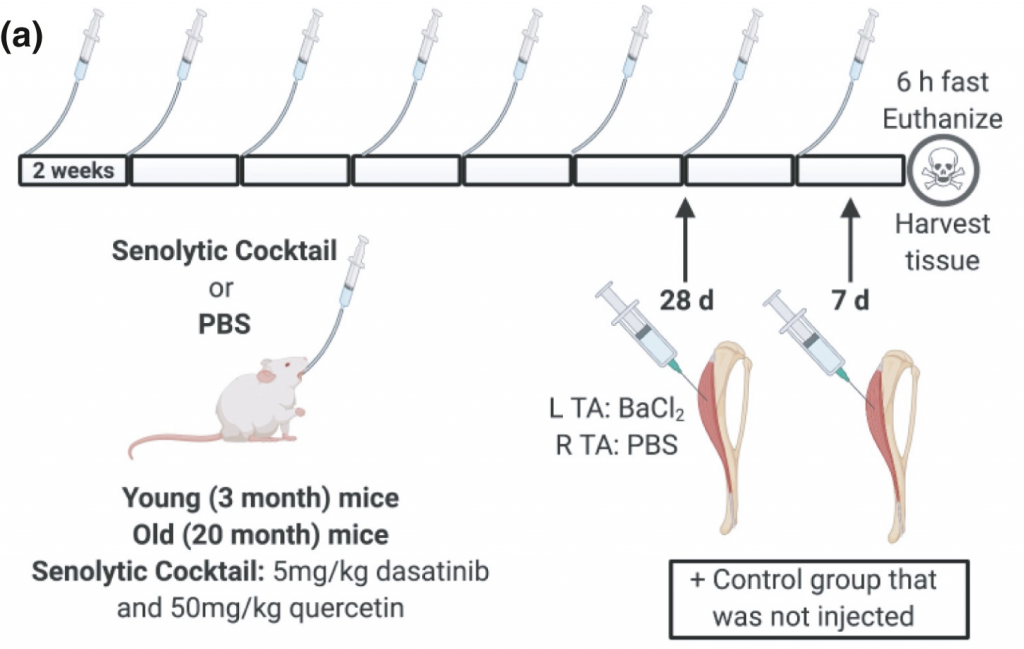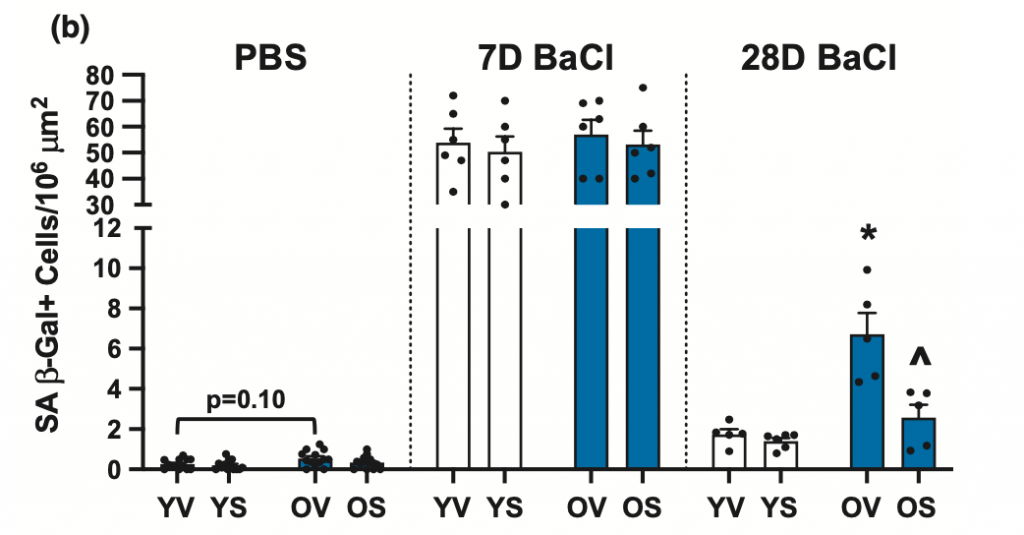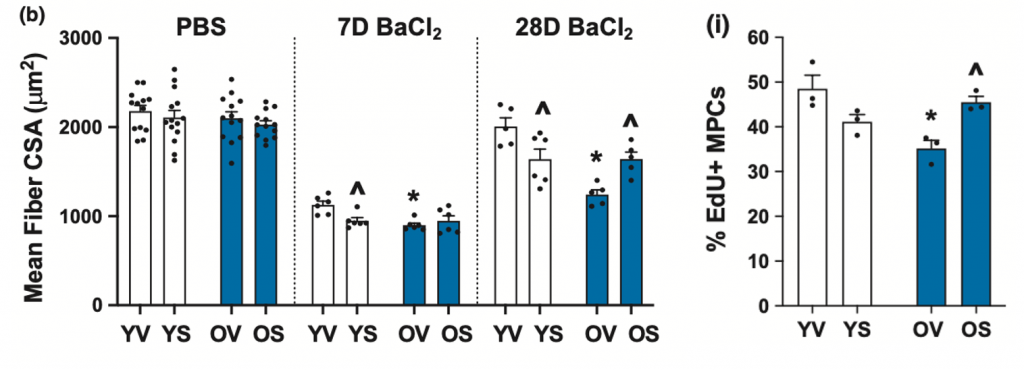Highlights:
- Old mice (20 months) treated with dasatinib and quercetin (D+Q) exhibit superior physical performance over old control mice.
- D+Q boosts muscle regeneration in old mice by removing senescent cells and increasing satellite cell proliferation.
- The muscles in old treated mice display larger muscle fibers than old control mice.
While certain activities like exercise can prolong muscle integrity as we age, our muscle’s regenerative potential inevitably crumbles. As we age, our muscles weaken due to the progressive elimination of satellite cells (muscle stem cells). These cells are imperative for skeletal muscle growth, development, and regeneration, but they shut down and stop proliferating, a state known as senescence. With this in mind, scientists push for effective therapeutics that can attenuate the wear and tear our muscles go through daily, specifically through satellite cell restoration.
Dungan and colleagues from the University of Kentucky published an article in Aging Cell that explores post-injury muscle regeneration in young and old mice following treatment with dasatinib and quercetin, two drugs that eliminate senescence cells. Initial findings show that the drug cocktail improves physical performance in old (20 months) mice but not young (3 months). What’s more, the Kentucky researchers find that the drug cocktail enhances muscle regeneration in old mice, primarily through boosting skeletal muscle precursors (satellite cells) and eliminating senescent cells. Notably, the muscles in old treated mice were more prominent, indicating an improved regenerative capacity in muscles. Together, the study’s findings suggest utilizing both dasatinib and quercetin as a regenerative therapeutic combination to combat muscle injury.
D+Q Boosts Physical Performance in Old Mice
The first thing that Dungan and colleagues did was to get a baseline on physical performance – specifically, balance and coordination – in young and old mice. To do so, they performed two tests: the balance beam test and the rotor rod test. For the balance beam test, investigators place mice on a balance beam and allow them to freely travel across the platform for one minute to familiarize themselves with the environment. Following a 30 minute break period, mice are placed back onto the start of the balance beam and are given 60 seconds to traverse the beam. With subsequent tests, the beam width gets smaller; testing begins on a 3 cm wide beam and progressively transitions to a 2 cm, 1 cm, and 0.5 cm beam. Old, untreated mice took the longest to cross each balance beam. Although D+Q treatment, which was orally administered, had little to no effect in young mice, old mice treated with D+Q displayed improvements in balance and physical performance, as evidenced by the shorter crossing times.
With the rotor rod test, investigators place mice on a spinning rod for one minute that completes a spin every 15 seconds, or four times per test. Mice that fall off during this period are immediately repositioned onto the rod to finish acclimatization. Thirty minutes after the training period, mice are given three attempts to stay on the rotating rod for as long as possible. Similar to the balance beam, young mice were unaffected by treatment. However, the senolytic cocktail appeared to boost physical performance in old mice, whose average time spent on the rotor rod was greater than old control mice.

Senolytic Cocktail Promotes Greater Muscle Regeneration in Old Mice
The Kentucky researchers then looked at post-injury muscle regeneration to further characterize the senolytic effects of D+Q. First, Duang and colleagues quantified senescent cell abundance in young and old mice over four weeks. Notably, investigators identified 10% of these cells to exhibit markers of senescence, with the remaining 90% being infiltrating immune cells called macrophages, which are vital contributors of muscle regeneration. However, the mere presence of senescence markers can promote harmful compounds called senescence associated secretory phenotypes (SASP), which, when emitted, cause a domino effect to induce more senescent cells.

(Dungan et al., 2021 | Aging Cell) Study design for evaluating the effect of senolytics on physical function in mice. Young and old mice were treated with a senolytic cocktail of D+Q bi-weekly for 4 months, so the mice were 7 months and 24 months of age, respectively, at the time of functional testing and tissue collection for analyses. To test the effect of D+Q on muscle regeneration, the tibialis anterior (TA) muscles of YV, YS, OV, and OS mice were injected with either PBS or BaCl2 and harvested after 7 or 28 days.
Thus, the researchers proposed that the senolytic cocktail would enhance muscle regeneration by reducing senescent cell levels, essentially limiting senescent cell burden. The findings showed minuscule differences between senescent cell abundance in control and treated mice (old and young) after seven days of treatment. But at the four-week mark, old treated mice displayed significantly lower levels of senescent cells, thereby diminishing SASP’s that may be responsible for impeding muscle regeneration.
Dungan and colleagues then looked at the size of muscle fibers following 28 days of treatment, as changes in baseline muscle size would indicate improved regenerative abilities. Although D+Q appeared to shrink muscle fibers in young mice, old mice exhibited markedly larger muscle fibers, confirming that senolytics promote muscle regeneration.
In correlation with these results, young treated mice presented lower levels of satellite cells than young control mice, pointing to the possibility that D+Q impairs muscle regeneration in youthful subjects. Be that as it may, results showed that the senolytic cocktail boosted satellite cell levels in old mice. All together, the combined findings demonstrate that D+Q effectively facilitates muscle regeneration only in elderly subjects.


Is D+Q Safe for Humans?
Although the study’s findings highlight the use of senolytics to improve muscle regeneration in aged mice, more research is needed to assess human translatability. The results of the first-in-human, single-arm, open-label clinical trial of dasatinib and quercetin were published in 2019. In this clinical trial, subjects with idiopathic pulmonary fibrosis, a cellular senescence-driven fatal disease, showed significantly improved walking endurance and gait speed, among other physical characteristics, just five days after nine doses of D+Q over three weeks. Researchers continue to evaluate D+Q treatment for many age-associated conditions, and ongoing clinical trials suggest that D+Q is safe and effective, with minimal toxicity.